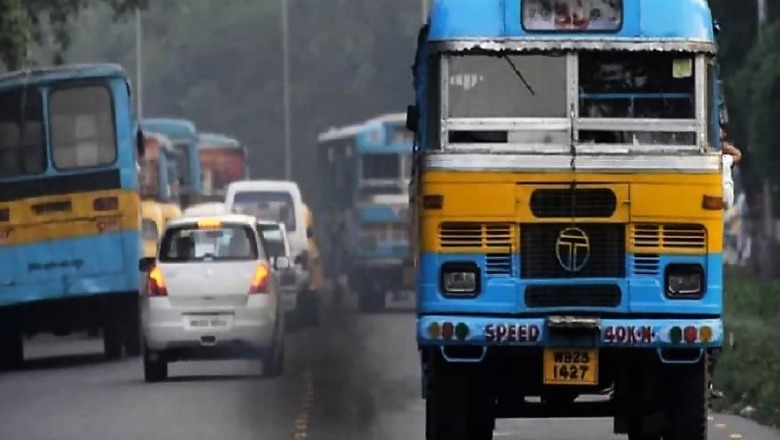
views
Kolkata: The City of Joy has good reason to be disconsolate. A 2016 World Health Organization (WHO) report showed Kolkata was the second-most polluted Indian metropolis, behind Delhi. And environmentalists say the air in the city is only getting worse.
A day after Diwali and Kali Puja this year, the Air Quality Index (AQI) near the Victoria Memorial was 282 – which is termed as ‘poor and unhealthy’. Interestingly, the structure abuts the expansive Maidan, or Brigade Parade Ground, known as the lungs of Kolkata.
At the Eastern Command headquarters in the city – which is also full of greenery – the AQI was 333, which is ‘very poor’. The situation was similar at Rabindra Sarovar and Rabindra Bharati during the festive season, with the AQI hovering between 345 and 385, which shocked environmentalists who said in these two areas the air quality is usually ‘moderate’.
According to the AQI standards, the level between 0-50 is considered ‘good’ and if it is between 51 and 100 then it is categorised as ‘satisfactory’. The level 101-200 is ‘moderate’ and anything between 201 and 300 is called ‘poor’. Between 301 and 400 is ‘very poor’, and 401-500 is ‘severe’. When the AQI shoots up above 500, the situation is described as ‘severe-plus emergency’.
“Can you believe the air quality around Victoria Memorial is ‘poor’?” said Kolkata- based environmentalist Soumendranath Ghosh. “These places are full of trees and open green spaces. This is alarming as Kolkata’s air quality is deteriorating. During Kali Puja and Diwali, the AQI level in Kolkata was almost the same as the national capital. In Delhi it was higher, but Kolkata was not far behind as far as poor air quality is concerned.”
During Diwali, the overall AQI in Delhi was hovering around 400 to 600 and in Kolkata (at eight places) it was around 350-400.
Surprisingly, Kolkata and adjoining metropolitan areas including Howrah, Hooghly, North 24 Parganas, South 24 Parganas and Nadia have far fewer vehicles and industries compared to the national capital region (NCR), and bursting of firecrackers during Diwali is also less. However, the Bengal capital remains between the top five most-polluted cities in India almost throughout the year.
“The reason behind the city being so polluted is the rampant usage of kerosene- mixed diesel by autorickshaw drivers in Kolkata Metropolitan Areas (KMAs) like Hooghly, Howrah, North 24 Parganas, South 24 Parganas and parts of Nadia. In Kolkata, most of the autorickshaws ply on LPG cylinders which is highly polluting because it contains nearly 60 per cent butane and 40 per cent propane.”
“Besides that, the most alarming fact is nearly 50,000 illegal ‘Vano’ (automated vans) are running on kerosene oil, which is very dangerous and highly polluting. If you go to the suburbs, you will see these Vano on the roads, and no one cares enough to seize these highly polluting vehicles,” he added.
Ghosh alleged that out of about 20 lakh vehicle owners in the city and its adjoining areas, nearly 35 to 40 per cent don’t go for regular pollution checks. “Even the private and government buses don’t,” he pointed out. “Last but not the least, I think that those who are conducting pollution checks should be qualified enough to do the job properly. I can challenge that most of the pollution checkers in the city are not qualified as agencies usually hire car mechanics for the job. As per rules, a person who conducts air pollution tests must have an automobile engineering diploma or equivalent to that, two years’ experience in workshop and he or she should have a driving licence. Unfortunately, no one cares. These are the factors which are making Kolkata one of the most polluted cities in India.”
Experts say road space in Kolkata is much less compared to Delhi, Chennai and Bengaluru. According to the Alipore and Beltala public vehicles departments (PVDs), the number of registered autorickshaws in the city is around 20,000 and they are supposed to ply on 123 routes across 144 wards. However, there are a large number of unregistered autos on Kolkata’s roads and most of them use poor-quality fuel, emitting toxic fumes.
The 2016 WHO report (based on data collected across 4,000 cities from 100 countries) says that in Kolkata, the annual mean of PM 2.5 (fine particulate matter) was 52 microgram per cubic metre in 2015 and in 2016 it increased to 74 microgram per cubic metre.
City-based environmentalists say Kolkata’s air quality is even worse than what the WHO report suggests. On Thursday, the AQI at the green Fort William touched 297, which is close to the ‘very poor’ category. At Ballygunge and Rabindra Bharati University, the levels were at 276 and 225 respectively, which is ‘poor’.
“There are nearly 20,000 roadside eateries in Kolkata using coal to cook food. Coal contributes 26 per cent to Kolkata’s air pollution, while 60 per cent is happening because of kerosene-mixed diesel and kerosene-run vehicles. This is alarming and the situation is just next to Delhi. Kolkata’s air quality is declining faster than Delhi and other metro cities. Urgent steps should be taken to make Kolkata greener and stringent steps should be taken against unregistered autorickshaws,” another Kolkata-based environmentalist Pradeep Chopra said.
“The roadside eateries are using poor-quality non-cooking coal (which is banned). The Kolkata Municipal Corporation officials and police should take stringent action against those who are responsible for Kolkata’s deteriorating air quality. Also, most of the power plants in and around the city are based on fossil fuels instead of solar like many in western and northern India. All vehicles run on petrol or diesel unlike Delhi where people are using CNG. Also, I feel that to reduce air pollution, Kolkata should have artificial intelligence-based smart signalling solutions to decongest traffic.”
According to the WHO, the safe limit of annual mean PM2.5 is 10 microgram per cubic metre, but the Indian standard is 40 microgram per cubic metre. In Kolkata, the annual mean of PM2.5 is seven times higher than the global safe limit.
The Centre for Science and Environment (CSE) says official ambient air quality monitoring has shown 61 per cent increase in particulate matter from 2010 to 2013. The rise is expected to be around 70 per cent now.
“If we want to improve the air quality in Kolkata, we should firstly work on increasing the open space percentage from seven per cent to at least 20 per cent,” Chopra said. “Secondly, ban kerosene-mixed diesel use by some unregistered autorickshaws and buses. Thirdly, deregister illegal autorickshaws plying on the city roads. Fourth is ban on usage of non-cooking coal by roadside eateries. And the fifth step to implement is the concept of vertical gardens on flyover pillars, commercial buildings, malls, etc. Mexico has done this by building vertical gardens on most flyover pillars.”
















Comments
0 comment